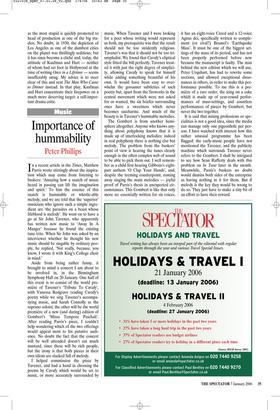Importance of hummability
Peter Phillips
In a recent article in the Times, Matthew Parris wrote stirringly about the inspiration which may come from listening to buskers: ‘Amazing how a snatch of music heard in passing can lift the imagination and spirit.’ To him the essence of this snatch is hummable or whistle-able melody, and we are told that the ‘superior’ musicians who ignore such a simple ingredient are ‘the parasites on a beast whose lifeblood is melody’. He went on to have a go at Sir John Tavener, who apparently has written new music to ‘Away In A Manger’ because he found the existing tune trite. When Sir John was asked by an interviewer whether he thought his new music should be singable by ordinary people, he replied, ‘Not really, because, you know, I wrote it with King’s College choir in mind.’ Aside from being rather funny, it brought to mind a concert I am about to be involved in, in the Birmingham Symphony Hall on 20 January. One half of this event is to consist of the world première of Tavener’s ‘Tribute To Cavafy’, with Vanessa Redgrave reading Cavafy’s poetry while we sing Tavener’s accompanying music, and Sarah Connolly as the soprano soloist; the other will be the world première of a new (and daring) edition of Gombert’s ‘Missa Tempore Paschali’. After reading Parris’s piece, I couldn’t help wondering which of the two offerings would appeal most to his putative audience. No doubt the fact that the concert will be well attended doesn’t cut much mustard, since these will be rich people, but the irony is that both pieces in their own idiom are stacked full of melody.
I helped commission the piece by Tavener, and had a hand in choosing the poems by Cavafy which would be set to music, or more accurately surrounded by music. When Tavener and I were looking for a poet whose writing would represent us both, my prerequisite was that the result should not be too stridently religious. Tavener’s was that it should not be too triumphalist. We found that Cavafy’s eliptical style fitted the bill perfectly. Tavener treated it with just the right degree of simplicity, allowing Cavafy to speak for himself while adding something beautiful of his own. It would have been easy to overwhelm the gossamer subtleties of such poetry but, apart from the fireworks in the central movement which were not asked for or wanted, the six briefer surrounding ones have a sweetness which never becomes saccharine. And much of the beauty is in Tavener’s hummable melodies.
The Gombert is from another hemisphere altogether. Anyone who knows anything about polyphony knows that it is made up of interlocking melodies: indeed in real polyphony there is nothing else but melody. The problem from the buskers’ point of view is hearing the tunes clearly enough in the often complex web of sound to be able to pick them out. I well remember as a child first hearing Gibbons’s eightpart anthem ‘O Clap Your Hands’, and, despite the teeming counterpoint, coming away singing the main melodies — joyful proof of Parris’s thesis in unexpected circumstances. This Gombert is like that only more so: essentially written for six voices, it has an eight-voice Creed and a 12-voice Agnus dei, specifically written to complement (or rival?) Brumel’s ‘Earthquake Mass’. It must be one of the biggest settings of the mass of its period, and has not been properly performed before now because the manuscript is faulty. The man behind the new edition which we will use, Peter Urquhart, has had to rewrite some sections, and allowed exceptional dissonances in others, in order to make this performance possible. To me this is a première of a rare order, the icing on a cake which is made up of year-round performances of mass-settings, and countless performances of pieces by Gombert, but never the two together.
It is said that mixing professions or specialities is not a good idea, since the media can manage only one pigeonhole per person. I have watched with interest how this rather unusual programme has been flagged: the early-music people have not mentioned the Tavener, and the publicity machine which surrounds Tavener never refers to the Gombert. I shall be intrigued to see how Sean Rafferty deals with this problem on In Tune later in the month. Meanwhile, Parris’s buskers no doubt would dismiss both sides of the enterprise as having nothing in it for them. But if melody is the key they would be wrong to do so. They just have to make a tiny bit of an effort to have their reward.





































 Previous page
Previous page